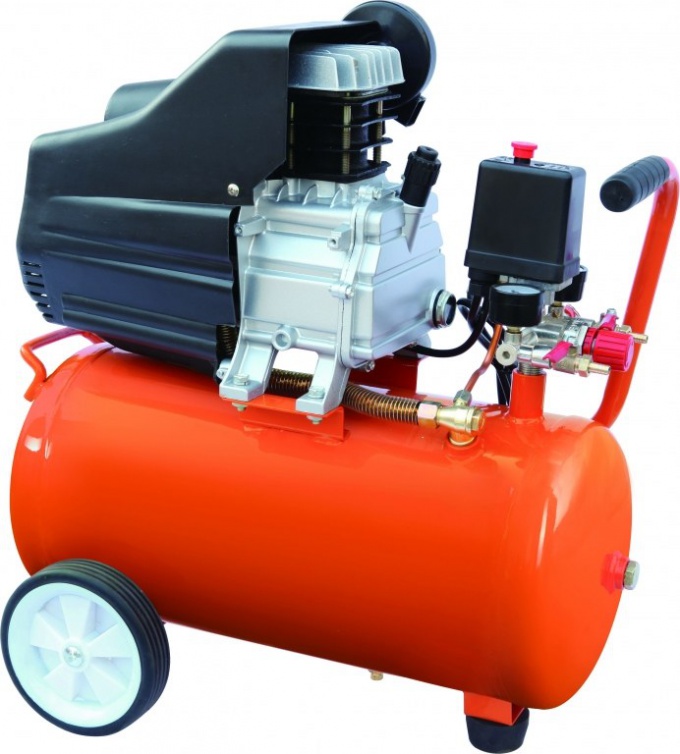The types of air compressors
Air compressors with capacity up to 100 cubic meters per minute can be divided into 2 type of construction:
piston;
- screw.
Both types of compressors can be equipped with an internal combustion engine and an electric motor. If necessary, they also come with wheels.
For nearly two centuries, piston compressors do not hand over their positions. The basis of this type of device is the compression of air by means of a translational return movements of the piston disposed within the housing. In the operating mode piston unit can provide air pressure to 30 atmospheres, so that it can be used for complex operations.
The main advantage of reciprocating compressors - high iznosoustojchivost and the possibility of their use at high loads. Thanks to resistance to aggressive influence of external environment is ensured by the durability of the whole device and its individual parts. With proper maintenance, this equipment is able to last a long time.
Piston compressors are compact and relatively inexpensive. The main disadvantage they have only one - these devices can function continuously. The piston compressor needs to rest every 20 minutes.
Screw compressors are more ergonomics. They are designed for long loads. With the ability to work uninterrupted for more than a day, such devices consume relatively little power. Because of the excellent performance screw compressors are industrial.
Basically screw compressors acquire woodworking enterprises, factories for the Assembly of cars and tools.
Operation of this equipment is based on compressing air between two blades of a continuously rotating rotor. This compressor has a compact size, making it convenient for use and carry.
Specifications of air compressors
The main technical characteristics of air compressors are:
- performance is causing a certain amount of compressed air per unit time;
- the volume of the receiver, which allows the device to operate at idle speed;
- pressure that is supplied at the output of compressed air.
Performance is the ability of compressed air per unit time. What compressors are more efficient, the more compressed air they can produce in a minute. The amount of the air outlet is often a crucial parameter setup, which and choose the model. Also, be aware that in the technical documentation for air compressor usually indicates the amount of air entering, which can significantly differ from the generated output.
Another parameter that choosing air compressors - volume of the receiver (a special reservoir designed to collect the compressed air). The larger the volume of the receiver, the more time can work on the pneumatic equipment when the compressor is offline. So you can periodically setting off, saving energy. In addition, the compressor unit due to the presence of the receiver has the ability to pump air set pressure.
Pressure is the third basic parameter of model selection of air compressor. Usually people are interested in the air pressure that is output, since the various pneumatic equipment requires compressed air at various pressures. If the work equipment is only possible when the supply of air under pressure, is strictly a certain number of atmospheres, this option may be the most important when choosing a device. Not every compressor has enough power to compress the air under strong pressure. A powerful piston device capable of reaching pressures up to 30 atmospheres. As for the screw counterparts, they are usually of such a high level is not short.
How to make a compressor with their hands
A good air compressor you can buy for 5 thousand rubles. However, some craftsmen made compressor devices with their hands. The main elements of a homemade air compressor:
unit that is capable of pumping air;
receiver;
- controls and assemblies.
- additional materials.
Are you buying the unit or is extracted from unused refrigerator make sure its in working condition. As a receiver it can serve as a five-gallon container from the fire extinguisher, which removed the rust and paint. Then it needs to be sanded and painted. As control elements and Assembly you will need: oxygen reducer, water fittings, dual power cord (about 2 meters) with a fork, household switch, pressure switch, and insulated wire for him.
Additional materials are:
- reinforced tube resistant to gasoline and oil rubber, length 1 m and diameter 4 mm;
- engine oil (mineral or semi-synthetic) – 500 g;
- 10 tightening metal clamps with a diameter slightly larger than the diameter of the rubber tube;
- thick silicone sealant;
- automotive filters (1 diesel and 2 petrol), which are used for the fine filtration of fuel.
First, change the compressor oil. Then screw the adapter into the hole of the receiver, pre-wound thread adapter tape to seal. Connect fitting-cross-piece with the adapter and at its upper output set relay air pressure on the Side you need to mount the diesel filter and oxygen reducer.
Further, with the withdrawal of the free cross using the adapter connect fitting and check valve. One end of the rubber tubing attach the clamp to the fitting and its other end secure with a clamp to the copper tube of the device. All fittings are complete using tape FUM, optionally processing them with silicone sealant.
Copper tube connect with a petrol filter and the other filter embed in the rubber tube between the compressor and the receiver. The connection of the pull straps. Then to the pressure switch connect the wires. You then need to do the serial connection to the power cable Assembly and switch. Relay air pressure should control the working pressure, and, if necessary, to close or break the circuit.
Attach to oxygen reducer reinforced PVC hose, which will allow you to continue to use the tools you'll need for compressor operation. For convenience, you can use it to fix wheelbase.
